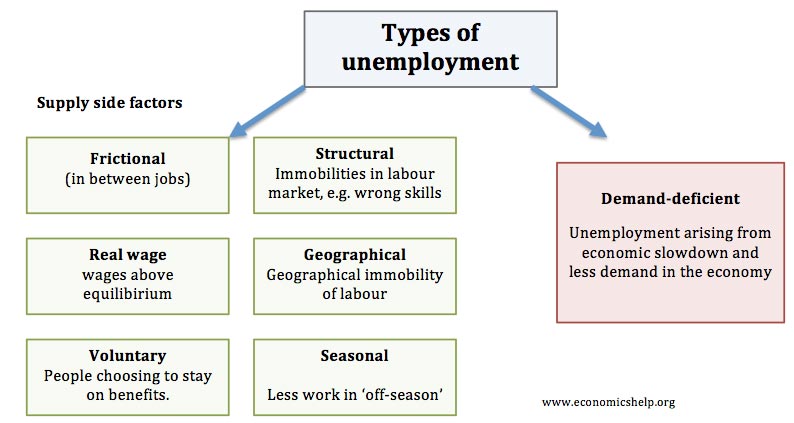Cyclical Unemployment and Frictional Unemployment
If growth can be sustained it should be possible to create a steady flow of new jobs. This type of unemployment occurs even in a healthy economy.

Natural Cyclical Structural And Frictional Unemployment Rates Video Khan Academy
Increase the unemployment rate.

. It is a result of imperfect information in the labor market because if job seekers knew that they would be. Whether structural cyclical or frictional unemployment understanding your unemployment is key to a faster more effective job search. Cyclical unemployment is the effect of businesses having less demand for workers to employ all those who are looking for jobs at within the business cycle.
As I noted in a previous post economists define three types of unemployment. Most economists believe that there is a short-run relation between the unemployment rate and inflation rate. Frictional structural and cyclical.
This factor alone would raise the natural rate of unemployment. These are seasonal unemployment cyclical unemployment frictional unemployment and structural unemployment. A demographic shift toward more mature workers would lower the natural rate.
Mark Thoma explains the difference between cyclical structural and frictional unemployment. There are always changes in the pattern of demand for different jobs the labour force needs to be sufficiently flexible to deal and adjust to this. There will always be some frictional unemployment.
Have an indeterminate impact on the unemployment rate. Cyclical unemployment is a result of the business cycle with unemployment rising during recessions and declining with economic. If an economy is doing good cyclical unemployment will be at its lowest and will be the highest if the economy growth starts to falter.
The second twostructural and frictionalmake up the natural unemployment rate. In other words the individual is left unemployed for a certain period as they transition into their new role. Frictional unemployment is defined as the unemployment that occurs because of people moving or changing occupationsDemographic change can also play.
Frictional unemployment is a count of people who leave one job for another and are temporarily unemployed. There are three main types of unemployment. The official definition of unemployment is as follows.
The weak economy led to. Some frictional unemployment is inevitable in a changing economy. During recessions highlighted in Figure 56 Unemployment Rate 19602011 the part of unemployment that is cyclical unemployment grows.
The other type of unemployment is cyclical unemployment which can create more unemployment. Frictional unemployment Frictional unemployment occurs when a worker moves from one job to another. Think back to the Great Recession of 2008.
The deviation between the two rates is cyclical unemployment and is related to the short-term ups and downs of economic activity. For many reasons the types of goods that firms and households demand vary over time. To calculate the cyclical unemployment rate subtract the total of the frictional unemployment rate and the structural unemployment rate from the current unemployment rate.
It occurs during a recession. Firstly the unemployment rate is calculated based on the labor force and not on the entire population. The analysis of fluctuations in the unemployment rate and.
Cyclical unemployment is a type of unemployment which is related to the cyclical trends in the industry or the business cycle. There are always cyclical fluctuations in employment. Frictional unemployment occurs when workers search for jobs.
Answer 3 Cyclical Unemployment. Unemployment can be temporary or permanent depending on whether it is caused by a reduction of force or by a lack of jobs. Now we need to pay attention to two points here.
Discouraged workers are not considered as a part of the labour force so classifying them as unemployed would. It also has four kinds of unemployment Unemployment Unemployment refers to a situation where individuals capable of working seek active opportunities for work but cannot find any for various reasons. Frictional unemployment comes.
Cyclical structural and frictional. Frictional unemployment occurs in the period between leaving one job and joining another. Cyclical employment is not considered naturally occurring and is seen as a.
There are four types of unemployment that are mainly responsible for causing unemployment in India. Unemployment occurs when a person who is a participant of the labor force and is actively searching for employment is unable to find a job. Frictional Unemployment Examples.
In general the actual unemployment rate fluctuates around the natural rate of unemployment. Types of unemployment Frictional unemployment Structural unemployment Cyclical or Keynesian unemployment Seasonal unemployment 5. Not change the unemployment rate.
Cyclical unemployment has to do with the upward and downward swings of the economy its cycle if you will. During the downturn people are buying fewer vehicles so the manufacturer doesnt need as. Most business cycles are.
Cyclical unemployment is unfortunately the most familiar. Cyclical unemployment relates to the business cycle in an industry. Frictional Unemployment Frictional Unemployment Frictional unemployment occurs when unemployed individuals look for jobs as a part of.
Cyclical Unemployment Rate Current Unemployment Rate Frictional Unemployment Rate Structural Unemployment Rate One concrete example of cyclical unemployment is when an automobile worker is laid off during a recession to cut labor costs. In turn this helps us distinguish frictional against cyclical unemployment.

Cyclical Unemployment Definition Example Phases How To Calculate

What Are The Different Types Of Unemployment

Nb2 Frictional Structural And Cyclical Unemployment Youtube

Types And Causes For Unemployment Frictional Structural Cyclical Youtube

Types Of Unemployment Economics Help

Types Of Unemployment Frictional Structural Cyclical And Seasonal Youtube
Comments
Post a Comment